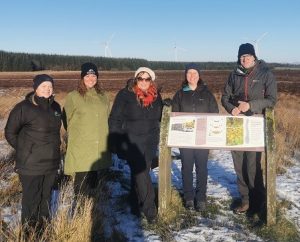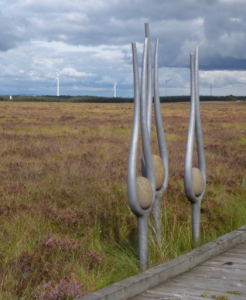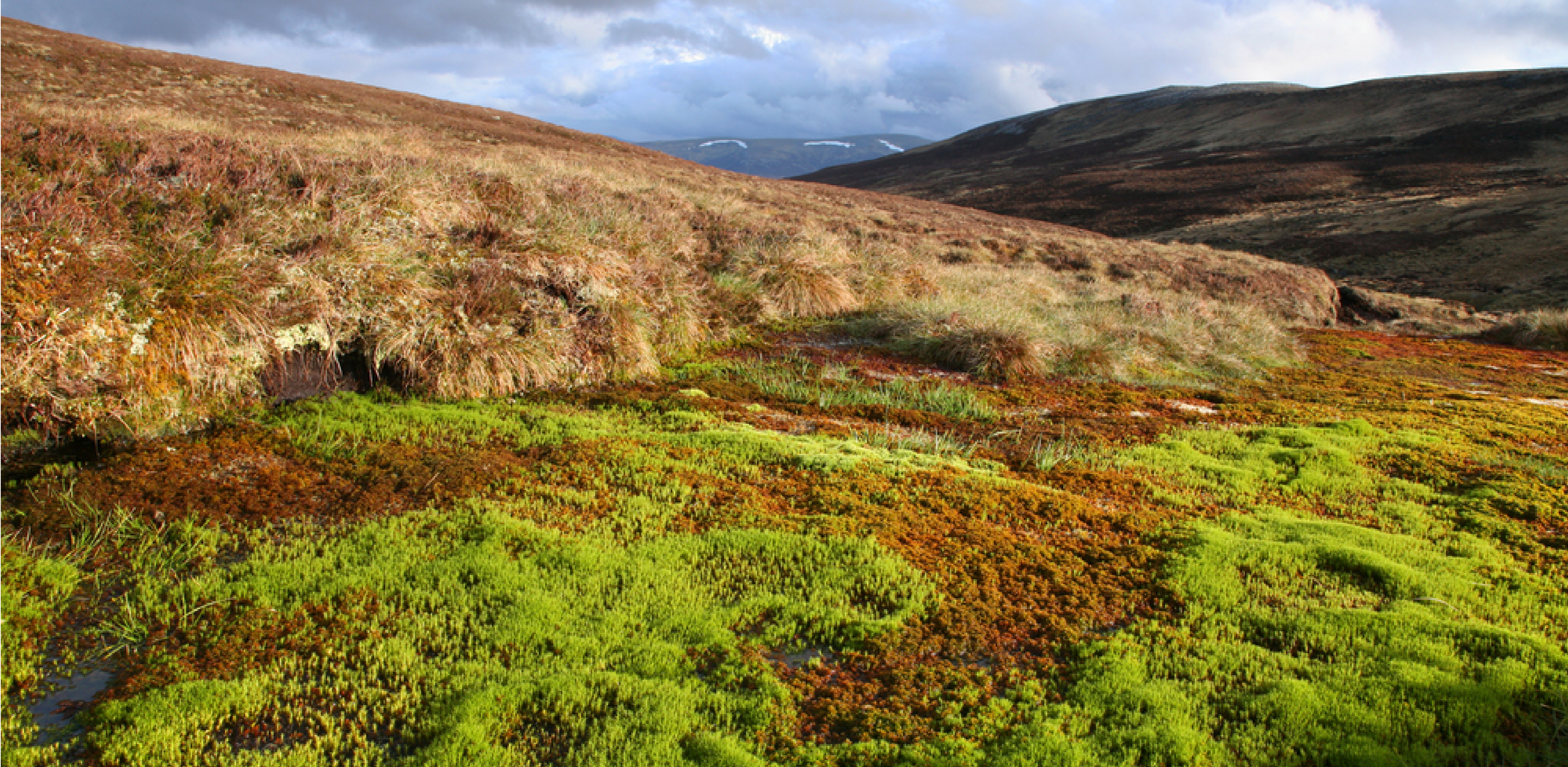Nature Champions visit to Blawhorn Moss National Nature Reserve with Fiona Hyslop MSP
What words spring to mind when you think of blanket bogs? Wet, wild, bleak, boggy, peaty, wonderful or expanse? Well for Fiona Hyslop MSP who is Scotland’s Nature Champion for blanket bogs its ‘extraordinary’ and Scotland’s blanket bogs really are extraordinary. Standing on a blanket bog in Scotland, looking out over the gently undulating moss hummocks and pools, you could be standing on several metres of peat, that has formed over thousands of years (as little as 1mm of peat is formed in a year) and represents a globally rare habitat.
In Scotland, blanket bogs cover around 1.8 million hectares, equating to 23% of our land area. Over 1.6 billion tonnes of carbon are stored in Scottish peatlands – a third of the carbon held in the Amazon rainforest, which is 250 times larger in area! The carbon stored in these soils is equivalent to over 180 years of the country’s greenhouse gas emissions at current emission rates. Healthy peatlands keep carbon locked up and continue to absorb more carbon. However, only around 20% of UK peatlands are in a natural, or semi-natural state due to human interventions and so are not only less effective in storing carbon, but actively release it.
The Nature Champions initiative encourages Members of the Scottish Parliament to champion threatened species and priority habitats, raising awareness and promoting action to restore and safeguard Scotland’s environment. CIEEM (Chartered Institute of Ecology and Environmental Management) is co-hosting blanket bogs with ARC (Amphibian and Reptile Conservation) and we were delighted that Fiona Hyslop MSP became the Nature Champion for blanket bogs. Fiona is also Deputy Convenor of the Net Zero, Energy and Transport Committee so of great relevance to her role.
Fiona was very excited to visit Blawhorn Moss National Nature Reserve (NNR) in her constituency in West Lothian on a cold crisp winter’s morning. Blawhorn Moss is a hidden gem and a rare survivor of the raised and blanket peat bogs that once covered much of Central Scotland. More information about Blawhorn Moss here.

Pictured left to right:
Amee Hood, NatureScot Reserve Manager
Rachael Cooper-Bohannon, ARC
Fiona Hyslop MSP
Annie Robinson, CIEEM
Barry Dunne, NatureScot Peatland Action Project Manager
Blanket bogs are also incredibly important for biodiversity including:
- Upland breeding birds – Golden Plover, Greenshank, Dunlin, Widgeon, and, in lochans, Red-throated Divers)
- Invertebrates – dragonflies, including the Black Darter, Four Spotted Chaser, Common Hawker and Azure Hawker – found only in the Scottish Highlands as well as the rare Bog Sun-jumper Spider
- Reptiles and amphibians – Adder – beautiful, shy snake that gives birth to live young, common lizard, palmate newt
- and of course the key component of blanket bogs Sphagnum mosses as well as peatland specialists such as Sundews and Butterworts which are carnivorous plants adapted to catch and digest small invertebrates.


Healthy blanket bogs act as giant sponges storing vast amounts of water, regulating, and slowing the movement of rainwater which helps to prevent downstream flooding. Like blanket bogs lowland raised bogs facilitate water flow regulation and store a massive amount of carbon. Lowland raised bogs are discreet, raised, dome-shaped masses of peat occupying former lakes or shallow depressions in the landscape. Blawhorn Moss NNR is a one of the best examples of a lowland raised bog in central Scotland.
In recent years, over a thousand dams have been installed at Blawhorn to restore the bog to its natural state by raising water levels. For centuries people drained bogs like Blawhorn for farmland and cut peat for fuel. Large-scale restoration is underway at many peatlands across Scotland via Peatland Action. In 2020, the Scottish Government announced significant annual investment in peatland restoration of more than £250 million up to 2030. Restoring peatlands is one of the most effective ways of locking in carbon; offering a clear nature-based solution to both the climate crisis and biodiversity loss. It requires continued investment, co-ordinated action at a regional and national scale and people with the skills needed to undertake the restoration. In addition, ecological and hydrological input is needed at all stages of the restoration with monitoring implemented to review and adjust management.
Fiona Hyslop MSP said:
I was pleased to accept an invitation to visit Blawhorn Moss National Nature Reserve which is the only National Nature Reserve in the Central Belt. As the Nature Champion for Scotland’s extraordinary blanket bogs I take a keen interest in our peatlands which cover 20% of Scotland.
‘This site near Blackridge in my Constituency is extremely important as active peatland bogs, like this one, can act like a carbon sink, helping us to reach our climate change goals.
‘While the site provides excellent climate and nature benefits, the Reserve also provides the local community with a great space for walks, with a boardwalk around the Moss to allow walking routes on the site while protecting the habitat.
‘I would encourage my Constituents to visit this incredible site and learn more about this excellent amazing site which is on our doorstep in West Lothian.
Only around 20% of UK peatlands are in a natural, or semi-natural, state meaning 80% have been altered by damage or drainage. Some of the leading causes of peatland degradation are:
- Extraction of peat for composts. The major use of peat is in horticulture. Amateur gardening accounts for 69% of total use.
- Inappropriate tree planting on blanket bogs and other peatlands, particularly on shallow peat soils.
- Inappropriate burning that does not follow the Muirburn Code leading to loss of Sphagnum and subsequent peat desiccation, shrinkage and erosion.
- Impacts of wind farms and other developments on blanket bog.
- Climate change – impacts of changes in rainfall and temperature as a consequence of climate change are complex, and it is recognised that increasing resilience through the restoration of degraded bog is a priority.
- Overgrazing by deer and sheep leading to bare areas of peat.
Action Needed
- Continuing and expanding the Peatland Action programme and other funding initiatives for large-scale restoration works, such as, prioritising investment in Scotland’s natural capital, as recommended in the Advisory Group on Economic Recovery Report, and supporting private investments for example through the Peatland Code. Rewetting bogs, repairing historical damage and re-vegetating bare peat is a key nature-based solution.
- Halting peatland degradation, firstly by banning peat-based compost sales in Scotland, while researching, developing and promoting the use of alternative composts.
- Ensuring that the ecosystem function, particularly the delicate natural water-based system, is not compromised by inappropriately planned activities such as tree planting, wind farms and other developments.
- Ensure that restoration efforts do not adversely impact species, ecological advice is key!
Find out more here.
